
If you regularly visited the gym at the start of the year, chances are, you spent a good part of the lockdown months trying to find a way to stay in shape while fitness clubs remained closed. It’s not easy rebooting your entire routine that way. Some people took up running. Others took up bicycling. Some folks bought some basic equipment and turned their garages into makeshift gyms.
Then, there were the folks who invested in smart home gym equipment. You know, those connected fitness equipment that came with video lessons, live instructions, and a whole bunch of sensors tracking every part of your workouts, allowing you to exercise all by your lonesome while receiving the benefit of regular feedback and, in some cases, even challenging your competitive juices by pitting your performance against other people using the same equipment.
It’s that category of home gym setups that probably benefited most from the extended shutdowns, as they really proved their value by keeping people engaged and connected on top of helping them stay fit. As such, they’ve grown in prominence over the last year, likely setting them up as a viable option for a good chunk of folks who don’t mind paying the steep upfront costs. If you’re thinking of investing in one of those systems for 2021, here’s a brief guide to the different offerings in the market, as well as their accompanying subscription services (if any).
Peloton Bike/Bike+
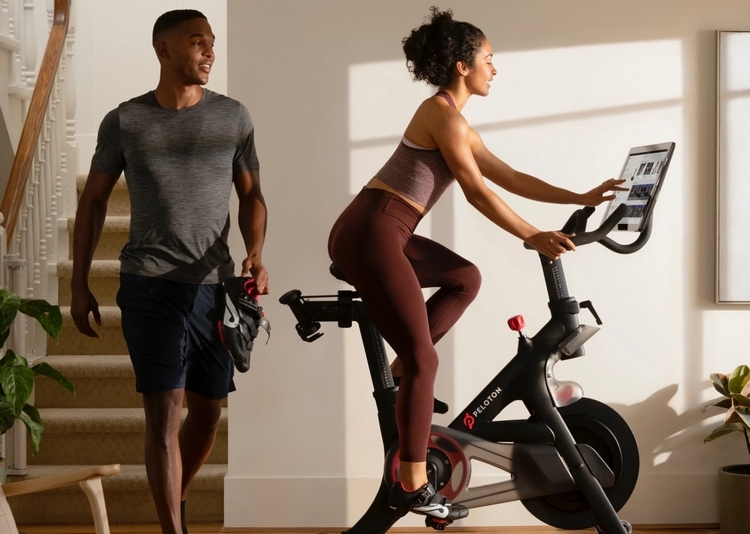
Peloton was a pioneer in the space, having been borne off a Kickstarter campaign way back in 2013. From 2014 onwards, they’ve been offering a stationary bike with an accompanying monthly subscription that allows you to participate remotely in group classes streamed from the outfit’s fitness studio. The classes are held frequently, too, at a rate of around seven per day, ensuring there’s likely one you can join, regardless of what time you decide to get your workout. And in case you decide to get your spin bike workout at a dastardly time of the night, you can just go for the on-demand classes instead.
This original product, which integrated a touchscreen on the bike for watching classes both live and on-demand, has become the de facto standard for the category, with most other companies following in their footsteps by integrating similar setups into their own exercise equipment. There are now two types of Peloton stationary bikes, Bike and Bike+, with the latter getting a larger rotating screen that allows you to face it in a different direction for those times you want to do other exercises. Yes, Peloton has now pivoted to a whole slew of classes beyond their original spin cycle roots, offering strength, yoga, cardio, meditation, barre, and more.
Price: $1,895 for the Bike, $2,495 for the Bike+, and $39 per month subscription
Peloton Tread/Tread+
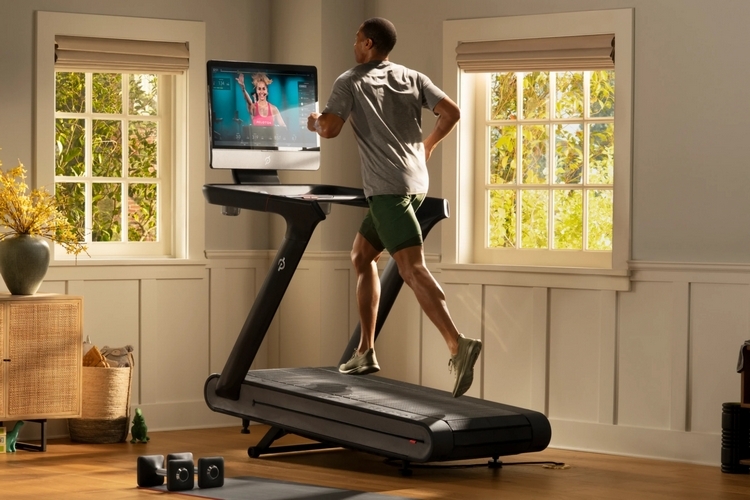
Prefer running to hitting the pedals when it comes to getting your cardio burn? This treadmill brings the same service for those who’d rather run, jog, and brisk walk, combining a powered treadmill with a large touchscreen out front for participating in live and on-demand group classes.
As with the bike, there are two versions: Tread and Tread+, with the former getting 59 inches of running space and the latter getting 67 inches. The latter also gets a larger touchscreen (32 inches versus 23.8 inches), although it also takes up way more space and weighs over 150 pounds heavier.
Price: $2,495 for the Tread, $4,295 for the Tread+, and $39 per month subscription
NordicTrack Commercial 2950

Want a smart treadmill, but don’t really care for the live classes Peloton offers? NordicTrack’s slightly more affordable offering might be more your style, as it gets you one of the most sophisticated treadmills in the market, along with iFit’s vast library of on-demand workout videos. We know, iFit has live classes, too, but it’s hardly a selling point given that they only do one or two per week, compared to Peloton’s seven daily classes.
This is one large treadmill, by the way, not dissimilar to the ones you’ll find in lined up across the floors of big box gyms all throughout the country, so make sure you have the space to actually accommodate a commercial-grade treadmill in your home. It can perform inclines up to 15 percent and declines up to 3 percent, with adjustable speed (1 to 12 mph), EKG grip sensors for reading your heart rate, dual fans to cool you down, and even integrated storage (cup holders and tray). The wide 22-inch HD screen lets you choose from iFit’s library of 17,000 workouts, complete with an interactive training feature that lets the system control the speed and incline to match whatever is showing onscreen. It also allows you to create custom workouts based on Google Maps, as well as track all your performance stats over time.
Price: $2,999 for the treadmill and $15 per month subscription (first 12 months free)
Hydrow Rower

Rowing offers one of the most effective and most efficient full-body workouts, as it’s able to recruit every single muscle group while bringing your heart rate up to involve your cardiovascular system. As a do-it-all fitness activity, it’s hard to beat. The Hydrow Rower brings all those benefits to your home workouts, all while providing livestreaming classes, on-demand instruction, and competitive leaderboards to keep you on track towards constant improvement.
We’re big fans of the actual equipment, with its fairly compact steel-and-aluminum frame and overall minimalist design. If you’ve ever used rowing equipment in big box gyms before, the quality feels very similar. It’s sturdy, too, able to support users up to 375 pounds, with an electromagnetic drag mechanism providing the necessary resistance, which you can adjust anywhere from a setting of 1 to 300.
It gets a 22-inch touchscreen display that’s set up right in front as you’re rowing, with options for tilting up to 15 degrees and pivoting up to 25 degrees. Aside from rowing classes, the package also includes yoga, pilates, and stretching videos if you want to change things up on occasion.
Price: $1,995 for the rowing machine and $38 per month subscription
Ergatta
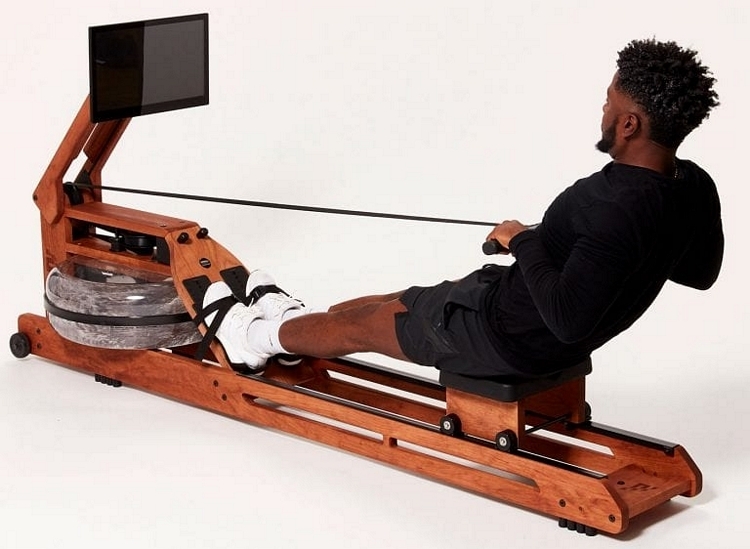
Another rowing-based subscription service, this one uses tried-and-tested equipment from WaterRower, which gets reinforced with a hinged arm on top for holding a 17.3-inch touchscreen. You can also order just the display panel and mount it onto your existing rower, if you already have one. This particular rowing machine comes with a wooden frame, which looks a lot better for home settings compared to commercial-grade all-metal rowers, although your personal preference will likely vary.
It uses a water-based resistance system that naturally adjusts with the effort you put in, so the harder you pull, the more resistance you’re going to feel. Yes, that’s similar to how it feels to row boats in the water, allowing this to better mimic the outdoor rowing experience. Oh yeah, that machine is incredibly sturdy, too, with a rated supported payload of up to 700 pounds, so even your cousin who works as a sumo wrestler in Japan can use your rower whenever he visits.
Like other similar services, you can use the touchscreen to find workouts you want to do. Unlike them, however, there are no streaming classes and on-demand instructor videos. Instead, it comes with a workout library that integrates goal-based training programs, game-based achievement systems, monthly challenges, and various dashboards. That’s right, there are no instructors here, with the screen showing nothing but numbers, charts, and stats that pertain to your real-time performance, so you don’t get the social aspect that other services strive to bring to customers.
Price: $2,199 for the rowing machine and $29 per month subscription
NordicTrack RW900 Rower
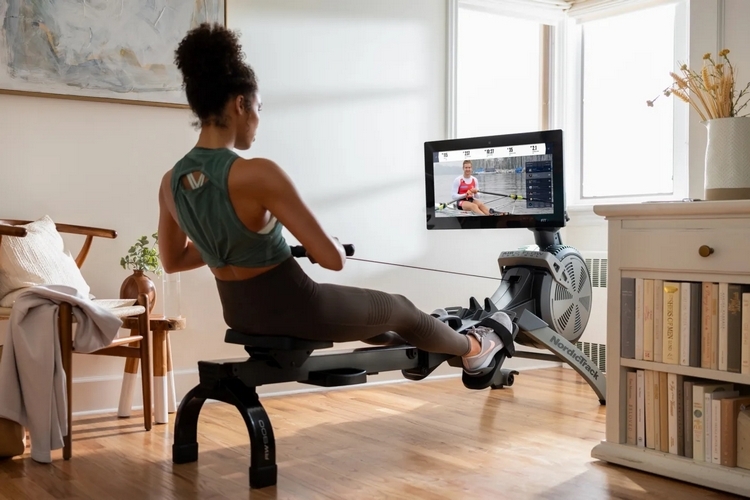
The NordicTrack RW900 is the most expensive of the outfit’s three rowing machines, combining a professional-looking rower with a 22-inch touchscreen display. It uses magnetic resistance that has 26 digital settings, with additional fine-tuning available by manually moving the air resistance handle out front. For the most part, though, relying on the digital settings should be good enough, especially since many of the workouts incorporate automatically adjusting the resistance based on the sequences being done, so all you have to do is keep rowing. You can opt, of course, to keep the resistance to your preferred manual settings.
It comes with a year of free iFit subscription, which gives you a variety of prerecorded indoor studio workouts and outdoor workouts filmed at bodies of water in over 40 countries, so you can imagine yourself in a quiet lake with the Loch Ness lurking somewhere underneath. The software, by the way, also supports creating your own custom workouts, so there’s a great deal of variety available here.
In case the RW900 is a little too rich for your tastes, you can opt for either the RW500 or the RW200, both of which are cheaper with fewer features and smaller displays. They do, however, also come with the same iFit software, so you get the same guided workouts at a lower entry price.
Price: $1,699 for the rowing machine and $15 per month subscription (first 12 months free)
Tempo Studio

For some people, working out is all about the weights. The Tempo Studio, basically, gets you a cabinet housing a variety of free weights equipment, including a barbell, two dumbbells, 16 weight plates, and even six collars (those things you put at the end to secure plates onto the bar). It also includes a heart rate monitor, a workout mat, and a foam roller. Do note, advanced lifters will definitely want to add their own plates to the mix, as they only included lightweight plates in the package.
You choose your workouts from the integrated 42-inch portrait display. Yes, 42 inches. No, they’re not trying to blind you with visuals. Instead, the larger screen is actually necessary, since it requires you to stand at least 5 feet away from the system. Why? Because it comes with 3D motion sensors that will monitor your exact movements, allowing it to not just know when you’ve finished a rep, but also whether you’re performing an exercise with the correct form, allowing it to offer you pinpoint guidance on the fly, so you can fix your form right in the middle of a set.
Price: $1,995 for the equipment and $39 per month subscription
JaxJox Interactive Studio
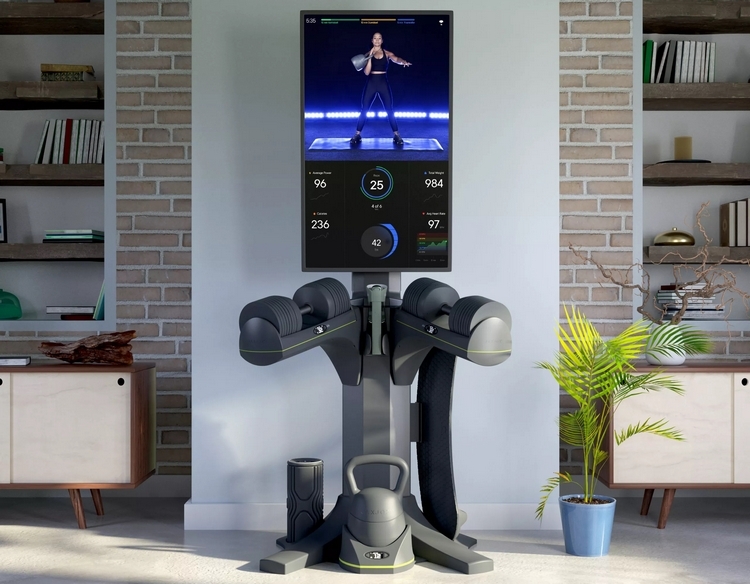
Two years ago, JaxJox entered the space with Kettlebell Connect, an adjustable kettlebell that came with live tracking and on-demand workout routines. This year, the outfit reinforced that lone dumbbell with a more expansive home gym setup in the form of the Interactive Studio.
Joining the adjustable kettlebell are a pair of adjustable dumbbells, a push-up trainer, and a vibrating roller, along with an equipment rack that also has a massive 43-inch display on top. It works much like other subscription home workout services, by the way, in which you can follow classes from the touchscreen, while onboard sensor keep a detailed record of your progress.
Designed for beginner and intermediate strength training, the kettlebells can be adjusted anywhere from 12 to 42 pounds, while the dumbbells can be adjusted anywhere from 8 to 50 pounds each. The push-up trainer, on the other hand, comes with four positions and the roller gets five vibration settings. If you want to lift weights while enjoying the same structured workouts and detailed activity tracking offered by the mostly cardio-based smart workout gear, we have a feeling you’ll find this a lot more to your liking.
Price: $2,199 for the equipment and $39 per month subscription
Tonal
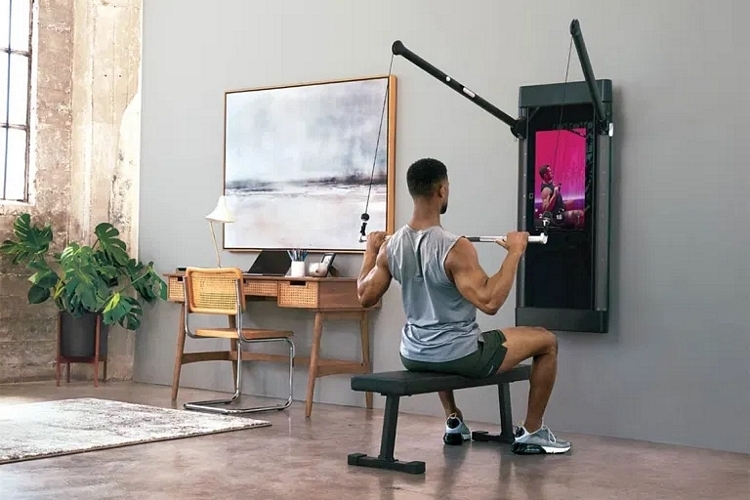
Much as we love using barbells, dumbbells, and kettlebells for resistance training, you have to admit, they’re not the most ideal for home workouts. Those things can do serious damage to your floors, after all, apart from being potentially dangerous if you have young children. That’s why, for home use, a cable machine can make for a much better alternative, as it allows you to perform proper resistance training exercises without the pitfalls of traditional free weights. And that’s what Tonal offers.
Even better, their custom equipment mounts cleanly up a wall using just 16 studs, where it takes up minimal space. Seriously, if you want to install a home gym that will require the least amount of room, this has to be near the top of your list. The equipment itself consists of a dual cable crossover machine, with the cables held on a pair of arms that can be slid up or down their own vertical rails, then tilted anywhere within a 180-degree angle. Equipped with adjustable magnetic resistance up to 200 pounds, this rig offers excellent versatility, allowing you to perform cable variations of nearly every strength training exercise you can imagine. It comes with a variety of handles that you can attach to change up your exercises, including individual cable handles, a bar, and a rope, along with a bench, a mat, and a foam roller.
It has an integrated 24-inch portrait touchscreen display where you can get guided video workouts, detailed instructions, and weight recommendations for every exercise. And yes, it can monitor every rep you complete, so it can keep a detailed log of your progress over time. It even has a “spotter mode” that will detect when you’re fatiguing and automatically reduce the weight to compensate, so it’s quite the impressive package.
Price: $2,995 for the equipment and $49 per month subscription
FightCamp
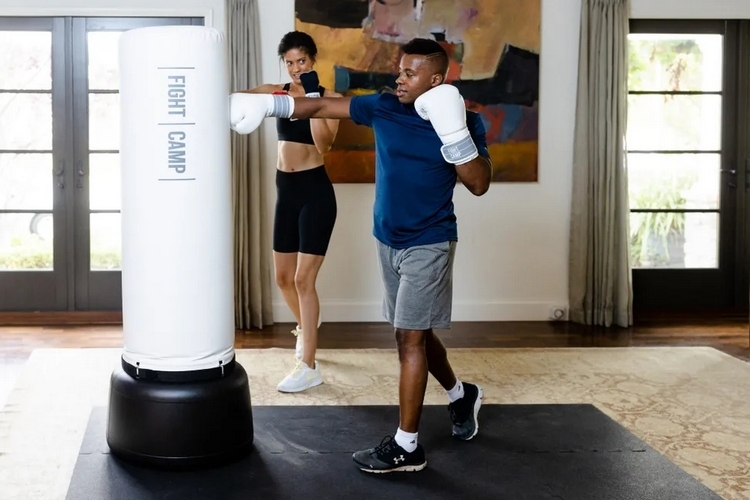
All these jumping, running, and lifting stuff is fun and all, but wouldn’t you rather just stay fit by punching and kicking stuff? If you answer in the affirmative, you may want to check out FightCamp, which gives you a large freestanding bag and a set of boxing gear. That gear includes a pair of “punch trackers,” which are sensors you clip onto the included hand wraps before slipping on the premium boxing gloves. Those sensors take care of monitoring the volume, speed, and impact of your throws, allowing the accompanying system to keep track of your overall performance.
Do note, it doesn’t come with its own screen. Instead, you can use the companion app on any iOS device (no Android), where you can get tutorials, workouts, and other training videos on demand. You won’t just be punching here, by the way, as the routines typically include various bodyweight exercises in between the hooks and crosses, so you can get a more complete workout.
Price: $1,219 for the equipment and $39 per month subscription
Mirror
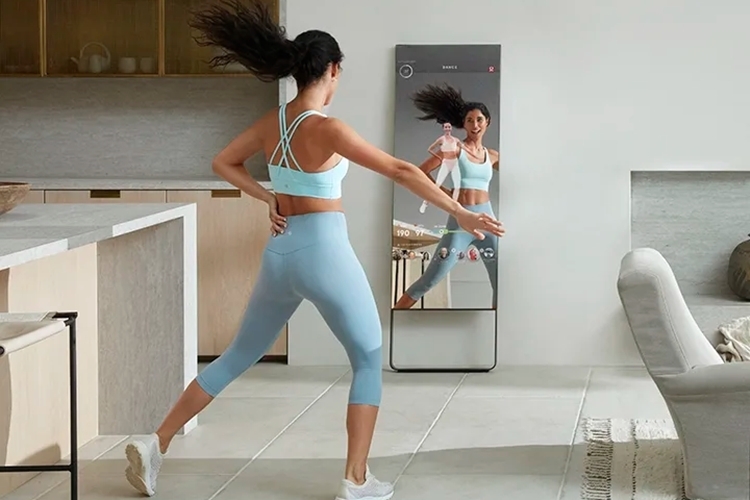
Don’t want your apartment to look like a gym? We understand. That’s where the Mirror comes in. It’s, literally, a mirror that you can mount up a wall, where you can check your clothes and your hair every morning. Except, it also doubles as a large vertical screen where you can follow a variety of on-demand workout videos.
It comes with no equipment, so you’ll have to supply that on your own (except the resistance bands, which come with the package). As for the workouts, they offer cardio, kettlebell, resistance bands, yoga, boxing, pilates, and other bodyweight-based exercises. Why won’t you just watch a YouTube video and follow that? Yes, you can do that. The appeal here, however, is the quality of instructors, since these are real pros who created workouts specifically for use by one person in the comfort of their home. As such, they come armed with plenty of motivational words to keep users engaged. A heart rate monitor is included, which the system uses to monitor your workouts. Basically, they judge your performance based on how consistent you’re able to stay in specific heart rate zones.
Miss the personal training you get from a traditional gym? You can get that here, with front-facing camera on the mirror allowing a trainer to keep an eye on your movements in real time, while they appear onscreen barking instructions and whatever else you need to get you through the grind. It’s going to cost a steep extra, though.
Price: $1,495 for the equipment and $39 per month subscription
